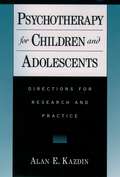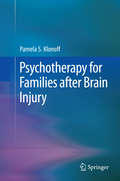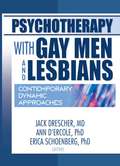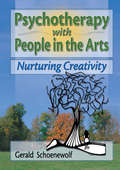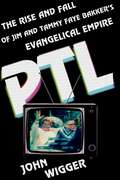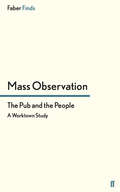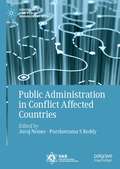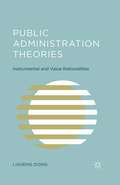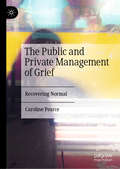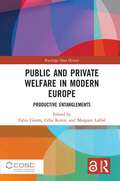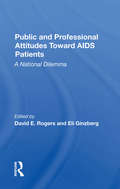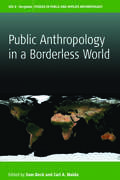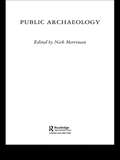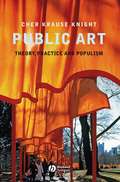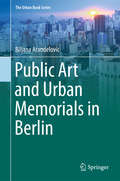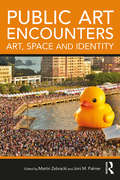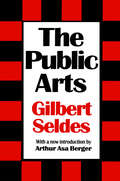- Table View
- List View
Psychotherapy for Children and Adolescents: Directions for Research and Practice
by Alan E. KazdinWhat do we wish to know about psychotherapy and its effects? What do we already know? And what needs to be accomplished to fill the gap? These questions and more are explored in this thoroughly updated book about the current status and future directions of psychotherapy for children and adolescents. It retains a balance between practical concerns and research, reflecting many of the new approaches to children that have appeared in the past ten years. Designed to change the direction of current work, this book outlines a blueprint or model to guide future research and elaborates the ways in which therapy needs to be studied. By focusing on clinical practice and what can be changed, it offers suggestions for improvement of patient care and advises how clinical work can contribute directly and in new ways to the accumulation of knowledge. Although it discusses in detail present psychotherapy research, this book is squarely aimed at progress in the future, making it ideal for psychologists, psychiatrists, and all mental health care practitioners.
Psychotherapy for Families after Brain Injury
by Pamela S. KlonoffWhether caused by illness, accident, or incident, brain injury requires multi-tiered resources for the patient and considerable external care and support. When recovery is sidelined by depression, anger, grief, or turmoil, family members and the support network have critical roles to play and need their own guidance and compassionate therapeutic interventions.Psychotherapy for Families after Brain Injury offers theoretical frameworks and eclectic techniques for working effectively with adult patients and their families at the initial, active and post-treatment phases of rehabilitation. This practical reference clarifies roles and relationships of the support network in interfacing with the loved one and addresses the understandably devastating and sometimes derailing emotions and psychosocial adversities. The content promotes psychoeducation and guided exercises, delineates “helpful hints” and coping tools and proffers multimedia resources to overcome hurdles. Constructs of awareness, acceptance and realism for all parties are woven throughout, along with ideas to enhance the support network’s commitment, adjustment, positivity, hope and longevity. Case excerpts, instructive quotes from caregivers and nuggets of clinical advice assist in analyzing these and other topics in salient detail:The impact of brain injury on different family members.Treatment themes in early family sessions.Family therapy for moderate to severe brain injury, concussion and postconcussion syndrome.Family therapy after organic brain injury: stroke, anoxia, tumor, seizure disorders.Family group treatment during active rehabilitation.End-of-life and existential considerations and positive aspects of care giving.Aftercare group therapy for long-term needs.The hands-on approach demonstrated in Psychotherapy for Families after Brain Injury will enhance the demanding work of a range of professionals, including neuropsychologists, clinical psychologists, rehabilitation psychologists, family therapists, marriage and family counselors, psychiatrists, behavioral/mental health counselors, clinical social workers, rehabilitation specialists such as speech-language pathologists, physical and occupational therapists, and graduate students in the helping professions.
Psychotherapy with Gay Men and Lesbians: Contemporary Dynamic Approaches
by Jack Drescher Ann D'Ercole Erica SchoenbergExamine gay and lesbian psychoanalysis from a variety of perspectives! Psychotherapy with Gay Men and Lesbians: Contemporary Dynamic Approaches presents case histories of psychotherapy sessions with gay and lesbian patients, focusing on today's psychoanalytical approaches. Dedicated to enhancing the emotional, psychological, and psychiatric treatment of gay men, lesbians, and bisexuals, the book features prominent analysts with a wide range of clinical and theoretical approaches. The foremost experts in the therapeutic field address issues affecting gay and lesbian patients from psychoanalytic perspectives that respect the patients' sexual identities. Psychotherapy with Gay Men and Lesbians reflects the significant clinical and theoretical changes therapists face in dealing with issues of gender and sexuality. New ways of thinking coexist with traditional theory as paradigm shifts in psychotherapy and psychoanalysis affect the treatment of gay, lesbian, and bisexual patients. This book provides a forum to address those changes through clinical papers and discussions. Psychotherapy with Gay Men and Lesbians includes discussion of case reports that deal with: gay therapists treating gay patients countertransferential enactments of sex and gender in treatment rethinking the meanings of homosexuality psychotherapeutic treatment of gay male patients with AIDS and much more! Psychotherapy with Gay Men and Lesbians is an essential forum for the exchange of clinical information on gay and lesbian psychotherapy. The book is a valuable resource for psychiatrists, psychologists, social work therapists, psychoanalysts, and anyone interested in today's psychoanalytic approaches to homosexuality.
Psychotherapy with Gay Men and Lesbians: Contemporary Dynamic Approaches
by Jack Drescher Ann D'Ercole Erica SchoenbergExamine gay and lesbian psychoanalysis from a variety of perspectives! Psychotherapy with Gay Men and Lesbians: Contemporary Dynamic Approaches presents case histories of psychotherapy sessions with gay and lesbian patients, focusing on today's psychoanalytical approaches. Dedicated to enhancing the emotional, psychological, and psychiatric treatment of gay men, lesbians, and bisexuals, the book features prominent analysts with a wide range of clinical and theoretical approaches. The foremost experts in the therapeutic field address issues affecting gay and lesbian patients from psychoanalytic perspectives that respect the patients' sexual identities. Psychotherapy with Gay Men and Lesbians reflects the significant clinical and theoretical changes therapists face in dealing with issues of gender and sexuality. New ways of thinking coexist with traditional theory as paradigm shifts in psychotherapy and psychoanalysis affect the treatment of gay, lesbian, and bisexual patients. This book provides a forum to address those changes through clinical papers and discussions. Psychotherapy with Gay Men and Lesbians includes discussion of case reports that deal with: gay therapists treating gay patients countertransferential enactments of sex and gender in treatment rethinking the meanings of homosexuality psychotherapeutic treatment of gay male patients with AIDS and much more! Psychotherapy with Gay Men and Lesbians is an essential forum for the exchange of clinical information on gay and lesbian psychotherapy. The book is a valuable resource for psychiatrists, psychologists, social work therapists, psychoanalysts, and anyone interested in today's psychoanalytic approaches to homosexuality.
Psychotherapy with People in the Arts: Nurturing Creativity
by Terry S Trepper Gerald SchoenewolfLearn to free creativity from the shackles of emotional conflicts!This riveting collection of case histories illustrates the dark interplay of neurosis and creativity. Psychotherapy with People in the Arts explores the struggles of writers, painters, actors, and composers to reconcile their overwhelming need to create and the self-doubts, frustrations, and neuroses that block their potential. In addition to ten inspiring tales of healing and self-knowledge, Psychotherapy with People in the Arts provides a solid introduction to the primary issues related to emotional disorders and creativity. It begins with a study of the notoriously reclusive and eccentric writer J. D. Salinger. Using both theory and case example, it shows how family history, present relations, and genetics can combine to impede the flow of an artist&’s natural gifts-and how a good therapist can help unblock that creative power. It also includes a series of tests to diagnose blocked creativity. Psychotherapy with People in the Arts explores such compelling themes as: dealing with racism and internalized self-hatred the conflict between commercial and high art anger and blocked tears the drive for an impossible perfection emotional alienation and sexual acting outPsychotherapy with People in the Arts is a fascinating look at a complex and controversial subject. Though not everyone is a professional artist, every human being has creative potential that can be blocked by emotional disturbances. And every therapist, mental health educator, and artist will find rich sources of information and inspiration in this book. Visit the author's website at http://www.livingcenter.net
Psychotherapy with People in the Arts: Nurturing Creativity
by Terry S Trepper Gerald SchoenewolfLearn to free creativity from the shackles of emotional conflicts!This riveting collection of case histories illustrates the dark interplay of neurosis and creativity. Psychotherapy with People in the Arts explores the struggles of writers, painters, actors, and composers to reconcile their overwhelming need to create and the self-doubts, frustrations, and neuroses that block their potential. In addition to ten inspiring tales of healing and self-knowledge, Psychotherapy with People in the Arts provides a solid introduction to the primary issues related to emotional disorders and creativity. It begins with a study of the notoriously reclusive and eccentric writer J. D. Salinger. Using both theory and case example, it shows how family history, present relations, and genetics can combine to impede the flow of an artist&’s natural gifts-and how a good therapist can help unblock that creative power. It also includes a series of tests to diagnose blocked creativity. Psychotherapy with People in the Arts explores such compelling themes as: dealing with racism and internalized self-hatred the conflict between commercial and high art anger and blocked tears the drive for an impossible perfection emotional alienation and sexual acting outPsychotherapy with People in the Arts is a fascinating look at a complex and controversial subject. Though not everyone is a professional artist, every human being has creative potential that can be blocked by emotional disturbances. And every therapist, mental health educator, and artist will find rich sources of information and inspiration in this book. Visit the author's website at http://www.livingcenter.net
PTL: The Rise and Fall of Jim and Tammy Faye Bakker's Evangelical Empire
by John WiggerIn 1974 Jim and Tammy Bakker launched their television show, the PTL Club, from a former furniture store in Charlotte, N.C. with half a dozen friends. By 1987 they stood at the center of a ministry empire that included their own satellite network, a 2300-acre theme park visited by six million people a year, and millions of adoring fans. The Bakkers led a life of conspicuous consumption perfectly aligned with the prosperity gospel they preached. They bought vacation homes, traveled first-class with an entourage and proclaimed that God wanted everyone to be healthy and wealthy. When it all fell apart, after revelations of a sex scandal and massive financial mismanagement, all of America watched more than two years of federal investigation and trial as Jim was eventually convicted on 24 counts of fraud and conspiracy. He would go on to serve five years in federal prison. PTL is more than just the spectacular story of the rise and fall of the Bakkers, John Wigger traces their lives from humble beginnings to wealth, fame, and eventual disgrace. At its core, PTL is the story of a group of people committed to religious innovation, who pushed the boundaries of evangelical religion's engagement with American culture. Drawing on trial transcripts, videotapes, newspaper articles, and interviews with key insiders, dissidents, and lawyers, Wigger reveals the power of religion to redirect American culture. This is the story of a grand vision gone wrong, of the power of big religion in American life and its limits.
PTL: The Rise and Fall of Jim and Tammy Faye Bakker's Evangelical Empire
by John WiggerIn 1974 Jim and Tammy Bakker launched their television show, the PTL Club, from a former furniture store in Charlotte, N.C. with half a dozen friends. By 1987 they stood at the center of a ministry empire that included their own satellite network, a 2300-acre theme park visited by six million people a year, and millions of adoring fans. The Bakkers led a life of conspicuous consumption perfectly aligned with the prosperity gospel they preached. They bought vacation homes, traveled first-class with an entourage and proclaimed that God wanted everyone to be healthy and wealthy. When it all fell apart, after revelations of a sex scandal and massive financial mismanagement, all of America watched more than two years of federal investigation and trial as Jim was eventually convicted on 24 counts of fraud and conspiracy. He would go on to serve five years in federal prison. PTL is more than just the spectacular story of the rise and fall of the Bakkers, John Wigger traces their lives from humble beginnings to wealth, fame, and eventual disgrace. At its core, PTL is the story of a group of people committed to religious innovation, who pushed the boundaries of evangelical religion's engagement with American culture. Drawing on trial transcripts, videotapes, newspaper articles, and interviews with key insiders, dissidents, and lawyers, Wigger reveals the power of religion to redirect American culture. This is the story of a grand vision gone wrong, of the power of big religion in American life and its limits.
The Pub and the People: A Worktown Study (Mass Observation social surveys #6)
by Mass ObservationMass Observation was founded in 1937 with the aim of researching the everyday lives of ordinary people in Britain. One of its best-loved publications is The Pub and the People (1943), a unique study of one of Britain's best-loved pastimes, describing how people behaved in pubs, what and how much they drank, and the decor and layout of the average pre-war alehouse. Alongside sociological interest it offers amusing insights into an era when supping pints was only for the roughest customers, and beer was considered helpful not only to general health ('There is no bad ale, so Grandma said') but also (contra the porter in Macbeth) to the act of love. 'The authors of this book have unearthed much curious information.' George Orwell, Listener'Anyone with an interest in the history of beer and pubs in Britain ought to read it.' Boak and Bailey's Beer Blog
Public Administration in Conflict Affected Countries (Governance and Public Management)
by Juraj Nemec Purshottama S ReddyThis book highlights the main factors determining the quality of public administration in conflict affected countries; and assesses to what extent the conflict determines and impacts on the performance of public administration in affected countries. The main value added by this book is confirming the general expectation that there is no direct and universal link between the conflict and public administration performance (and vice-versa). One may need to argue that each country situation differs and specific factors of internal and external environments determine the trends of public administration performance in conflict affected countries. To achieve the overarching goal of the book, sixteen country studies were developed from all relevant continents - America, Africa, Asia and Europe: Bangladesh, Colombia, Croatia, Egypt, Georgia, Iraq, Kosovo, Nigeria, Palestine, Paraguay, Philippines, Serbia, South Africa, Uganda, Ukraine, and Venezuela.
Public Administration Theories: Instrumental and Value Rationalities
by L. DongThe book examines key public administration theories from the perspective of instrumental and value rationalities. The theories are analyzed on core value, assumption about human nature, methodology, role of government, and disciplinary positioning. The author traces the historical trajectory of each of the two camps of theories.
The Public and Private Management of Grief: Recovering Normal
by Caroline PearceThrough a critical analysis of theory, policy and practice, The Public and Private Management of Grief looks at how 'recovery' is the prevailing discourse that measures and frames how people grieve, and considers what happens when people 'fail' to recover. Pearce draws on in-depth interviews with bereaved people and a range of bereavement professionals, to contemplate how ‘failures’ to recover are socially perceived and acted upon. Grounded in Foucauldian theory, this book problematises the notion of recovery, and instead argues for the acknowledgment of the experience of ‘non-recovery,’ highlighting how recovery is a socially and historically constructed notion linked to the individualised vision of health and happiness promoted by neo-liberal governmentality. This book will be of interest to students and scholars across sociology, anthropology, social work and psychology with a focus on death, dying and bereavement, grief studies, health and social care, as well as counsellors, clinical psychologists and social workers.
Public and Private Welfare in Modern Europe: Productive Entanglements (Routledge Open History)
by Fabio GiomiSince the 1980s, neoliberals have openly contested the idea that the state should protect the socio-economic well-being of its citizens, making ‘privatization’ their mantra. Yet, as historians and social scientists have shown, welfare has always been a ‘mixed economy’, wherein private and public actors dynamically interacted, collaborating or competing with each other in the provision of welfare services. This book will be of interest to students, scholars and practitioners of welfare by developing three innovative approaches. Firstly, it illuminates the productive nature of public/private entanglements. Far from amounting to a zero-sum game, the interactions between the two sectors have changed over time what welfare encompasses, its contents and targets, often engendering the creation of new fields of intervention. Secondly, this book departs from a well-established tradition of comparison between Western nation-states by using and mixing various scales of analysis (local, national, international and global) and by covering case studies from Spain to Poland and France to Greece in the nineteenth and twentieth centuries. Thirdly, this book goes beyond state centrism in welfare studies by bringing back a host of public and private actors, from municipalities to international organizations, from older charities to modern NGOs.
Public and Private Welfare in Modern Europe: Productive Entanglements (Routledge Open History)
by Fabio Giomi Célia Keren Morgane LabbéSince the 1980s, neoliberals have openly contested the idea that the state should protect the socio-economic well-being of its citizens, making ‘privatization’ their mantra. Yet, as historians and social scientists have shown, welfare has always been a ‘mixed economy’, wherein private and public actors dynamically interacted, collaborating or competing with each other in the provision of welfare services. This book will be of interest to students, scholars and practitioners of welfare by developing three innovative approaches. Firstly, it illuminates the productive nature of public/private entanglements. Far from amounting to a zero-sum game, the interactions between the two sectors have changed over time what welfare encompasses, its contents and targets, often engendering the creation of new fields of intervention. Secondly, this book departs from a well-established tradition of comparison between Western nation-states by using and mixing various scales of analysis (local, national, international and global) and by covering case studies from Spain to Poland and France to Greece in the nineteenth and twentieth centuries. Thirdly, this book goes beyond state centrism in welfare studies by bringing back a host of public and private actors, from municipalities to international organizations, from older charities to modern NGOs.
Public And Professional Attitudes Toward Aids Patients: A National Dilemma
by David E. Rogers Eli GinzbergThis volume analyzes in considerable depth how fears, prejudices, social and moral values, and individual perceptions have affected and shaped the public, the personal, the professional, and the economic ways in which our society interacts with people suffering from HIV infections.
Public And Professional Attitudes Toward Aids Patients: A National Dilemma
by David E. Rogers Eli GinzbergThis volume analyzes in considerable depth how fears, prejudices, social and moral values, and individual perceptions have affected and shaped the public, the personal, the professional, and the economic ways in which our society interacts with people suffering from HIV infections.
Public Anthropology in a Borderless World (Studies in Public and Applied Anthropology #8)
by Sam Beck Carl A. MaidaAnthropologists have acted as experts and educators on the nature and ways of life of people worldwide, working to understand the human condition in broad comparative perspective. As a discipline, anthropology has often advocated — and even defended — the cultural integrity, authenticity, and autonomy of societies across the globe. Public anthropology today carries out the discipline’s original purpose, grounding theories in lived experience and placing empirical knowledge in deeper historical and comparative frameworks. This is a vitally important kind of anthropology that has the goal of improving the modern human condition by actively engaging with people to make changes through research, education, and political action.
Public Archaeology: The Past, The Heritage And The Public (University College London Institute Of Archaeology Publications)
by Nick MerrimanScrutinizing, in detail, the relationship between archaeology, heritage and the public, this much-needed volume explores public interest and participation in archaeology as a subject worthy of academic attention in its own right. Examining case studies from throughout the world; from North America, Britain, Egypt and Brazil to East Africa, China and beyond, Nick Merriman focuses on two key areas: communication and interpretation, and stakeholders. Constant reports of new discoveries, protests over the destruction of sites and debates over the return of artefacts such as the Elgin marbles or indigenous remains testify to an increasing public interest in archaeology. For students and scholars of this archaeology, and of its relationship with the public, this will prove essential reading.
Public Archaeology
by Nick MerrimanScrutinizing, in detail, the relationship between archaeology, heritage and the public, this much-needed volume explores public interest and participation in archaeology as a subject worthy of academic attention in its own right. Examining case studies from throughout the world; from North America, Britain, Egypt and Brazil to East Africa, China and beyond, Nick Merriman focuses on two key areas: communication and interpretation, and stakeholders. Constant reports of new discoveries, protests over the destruction of sites and debates over the return of artefacts such as the Elgin marbles or indigenous remains testify to an increasing public interest in archaeology. For students and scholars of this archaeology, and of its relationship with the public, this will prove essential reading.
Public Art: Theory, Practice and Populism (Blackwell Companions To Art History Ser.)
by Cher Krause KnightThis book takes a bold look at public art and its populist appeal, offering a more inclusive guide to America's creative tastes and shared culture. It examines the history of American public art – from FDR's New Deal to Christo's The Gates – and challenges preconceived notions of public art, expanding its definition to include a broader scope of works and concepts. Expands the definition of public art to include sites such as Boston's Big Dig, Las Vegas' Treasure Island, and Disney World Offers a refreshing alternative to the traditional rhetoric and criticism surrounding public art Includes insightful analysis of the museum and its role in relation to public art
Public Art and Urban Memorials in Berlin (The Urban Book Series)
by Biljana ArandelovicThis book provides insight into the significant area of public art and memorials in Berlin. Through diverse selected examples, grouped according to their basic character and significance, the most important art projects produced in the period since World War II are presented and discussed. Both as a critical theoretical work and rich photo book, this volume is a unique selection of Berlin’s diverse visual elements, contemporary and from the recent past. Some artworks are very famous and are already symbols of Berlin while others are less well known. Public Art and Urban Memorials in Berlin analyzes the connections created by public art on one hand, and urban space and architectural forms on the other.This volume considers the Berlin works of iconic artists such as Christo and Jeanne-Claude, Daniel Libeskind, Dani Karavan, Bernar Venet, Keith Haring, Christian Boltanski, Richard Serra, Peter Eisenman, Henry Moore, Claes Oldenburg and Coosje van Brüggen, Wolf Vostell, Gerhard Richter, Eduardo Chillida, Jonathan Borofsky, Olaf Metzel, Sol LeWitt, Frank Gehry, Max Lingner, Bernhard Heiliger, Frank Thiel, Juan Garaizabal and more. The reader is led through seven chapters: Creative City Berlin, Introduction to Public Art, Public Art in Berlin, the Celebration of Berlin’s 750th Anniversary in 1987, Temporary public art, Socialist Realism in Art, and Urban Memorials. The chapter Public Art in Berlin discusses selected projects, Bundestag Public Art Collection, Public Art at Potsdamer Platz and The City and the river – a renewed relationship. The chapter on urban memorials discusses: Remembering the Divided City and Holocaust Memorials in Berlin. The book delivers nine interviews with artists whose Berlin work is revealed through this volume (Bernar Venet, Hubertus von der Goltz, Dani Karavan, Juan Garaizabal, Susanne Lorenz, Kalliopi Lemos, Frank Thiel, Karla Sachse and Nikolaus Koliusis).
Public Art Encounters: Art, Space and Identity
by Martin Zebracki Joni M. PalmerPublic art is produced and ‘lived’ within multiple, interlaced and contested political, economic, social and cultural-symbolic spheres. This lively collection is a mix of academic and practice-based writings that scrutinise conventional claims on the inclusiveness of public art practice. Contributions examine how various social differences, across class, ethnicity, age, gender, religion, ability and literacy, shape encounters with public art within the ambits of the design, regeneration and everyday experiences of public spaces. The chapters richly draw on case studies from the Global North and South, providing comprehensive insights into the experiences of encountering public art via a variety of scales and realms. This book advances critical insights of how socially practised public arts articulate and cultivate geographies of social difference through the themes of power (the politics of encountering), affect (the embodied ways of encountering), and diversity (the inclusiveness of encountering). It will appeal to scholars, students and practitioners of cultural geography, the visual arts, urban studies, political studies and anthropology.
Public Art Encounters: Art, Space and Identity
by Martin Zebracki Joni M. PalmerPublic art is produced and ‘lived’ within multiple, interlaced and contested political, economic, social and cultural-symbolic spheres. This lively collection is a mix of academic and practice-based writings that scrutinise conventional claims on the inclusiveness of public art practice. Contributions examine how various social differences, across class, ethnicity, age, gender, religion, ability and literacy, shape encounters with public art within the ambits of the design, regeneration and everyday experiences of public spaces. The chapters richly draw on case studies from the Global North and South, providing comprehensive insights into the experiences of encountering public art via a variety of scales and realms. This book advances critical insights of how socially practised public arts articulate and cultivate geographies of social difference through the themes of power (the politics of encountering), affect (the embodied ways of encountering), and diversity (the inclusiveness of encountering). It will appeal to scholars, students and practitioners of cultural geography, the visual arts, urban studies, political studies and anthropology.
The Public Arts (Classics In Communication And Mass Culture Ser.)
by Gilbert SeldesFirst published in 1956 and then again in 1994. Seldes can be viewed as a pioneer of popularising and giving value to popular culture in his various publications since 1924. The Public Arts first published in 1956 starts with a letter to Jimmy Durante and Edward R. Murrow in which Seldes suggests that news and entertainment are 'part of one field' and that 'the lively arts and the mass media are two aspects of the same phenomenon' which can be captured in the term 'the public arts'. Popular culture refers to the world of situation comedies, comic strips, MTV. radio and television talk shows, football games, standup comedians, mystery stories, popular romance novels, and so on. Elite culture refers to operas, ballets, classical music, masterworks of painting and sculpture, serious novels and plays and other art forms that require, generally speaking, relatively sophisticated sensibilities. Many critics now argue that it is now unauthenticated to argue that popular culture and elite culture are different.
The Public Arts (Classics In Communication And Mass Culture Ser.)
by Gilbert SeldesFirst published in 1956 and then again in 1994. Seldes can be viewed as a pioneer of popularising and giving value to popular culture in his various publications since 1924. The Public Arts first published in 1956 starts with a letter to Jimmy Durante and Edward R. Murrow in which Seldes suggests that news and entertainment are 'part of one field' and that 'the lively arts and the mass media are two aspects of the same phenomenon' which can be captured in the term 'the public arts'. Popular culture refers to the world of situation comedies, comic strips, MTV. radio and television talk shows, football games, standup comedians, mystery stories, popular romance novels, and so on. Elite culture refers to operas, ballets, classical music, masterworks of painting and sculpture, serious novels and plays and other art forms that require, generally speaking, relatively sophisticated sensibilities. Many critics now argue that it is now unauthenticated to argue that popular culture and elite culture are different.
